THE REGULATIONS ABOUT OFFICIALS.
The question now arises whether the new colonists had better rights legally than the old citizens, and whether they had the majority of votes and elected city officers from their own number. The inscriptions with which we have to deal are both fragments of lists of city officers, and in the longer of the two, one gives the officers for four years, the corresponding column for two years and part of a third. A Dolabella, who belongs to the gens Cornelia, as we have seen, heads the list as duovir. The aedile for the same year is a certain Rotanius.[253] This name is not found in the sepulchral inscriptions of the city of Rome, nor in the inscriptions of Praeneste except in this one instance. This man is certainly one of the new colonists, and probably a soldier from North Italy.[254] Both the quaestors of the same year are given. They are M. Samiarius and Q. Flavius. Samiarius is one of the famous old names of Praeneste.[255] In the same way, the duovirs of the next year, C. Messienus and P. Cornelius, belong, the one to Praeneste, the other to the colonists,[256] and just such an arrangement is also found in the aediles, Sex. Caesius being a Praenestine[257], L. Nassius a colonist. Q. Caleius and C. Sertorius, the quaestors of the same year, do not appear in the inscriptions of Praeneste except here, and it is impossible to say more than that Sertorius is a good Roman name, and Caleius a good north Italian one.[258] C. Salvius and T. Lucretius, duovirs for the next year, the recurrence of Salvius in another inscription,[259] L. Curtius and C. Vibius, the aediles,—Statiolenus and C. Cassius, the quaestors, show the same phenomenon, for it seems quite possible from other inscriptional evidence to claim Salvius, Vibius,[260] and Statiolenus[261] as men from the old families of Praeneste. The quinquennalis for the next year, M. Petronius, has a name too widely prevalent to allow any certainty as to his native place, but the nomen Petronia and Ptronia is an old name in Praeneste.[262] In the second column of the inscription, although the majority of the names there seem to belong to the new colonists, as those in the first column do to the old settlers, there are two names, Q. Arrasidius and T. Apponius, which do not make for the argument either way.[263] In the smaller fragment there are but six names: M. Decumius and L. Ferlidius, C. Paccius and C. Ninn(ius), C. Albinius and Sex. Capivas, but from these one gets only good probabilities. The nomen Decumia is well attested in Praeneste before the time of Sulla.[264] In fact the same name, M. Decumius, is among the old pigne inscriptions.[265] Paccia has been found this past year in Praenestine territory, and may well be an old Praenestine name, for the inscriptions of a family of the name Paccia have come to light at Gallicano.[266] Capivas is at least not a Roman name,[267] but from its scarcity




